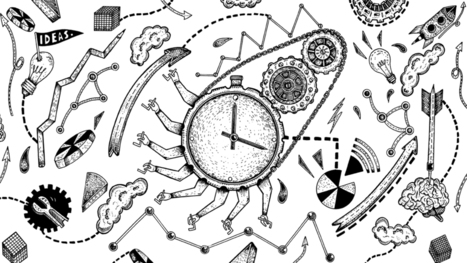 Your new post is loading...
 Your new post is loading...
With all the “be your best self now!” hullabaloo, we can get overwhelmed with what we think we should be doing. We can drive ourselves crazy thinking about all the things we could do to make ourselves smarter, stronger, better. Not long ago, I actually found myself surrounded by whiteboards sketching out all of my self-improvement plans for the year, kanban board style. And while goals and growth plans are great, sometimes the best ideas for change come from an awareness outside of ourselves. I know, it sounds weird to hear a leadership coach telling you to look for something outside of yourself. I’m all about tuning into that courageous and all-knowing voice who can tout your fabulousness–it’s good stuff. But let’s get real: Sometimes the only way to get perspective about what needs to change comes from an outside perspective. Yes, believe it or not, there is often a gap between who we desire and think we are presenting to the world, and the way others see us. Turns out that when you ask the people around you–the ones who see you in action every day and are impacted by the choices you make–where you can grow, their ideas might be a little different than your own.
Via The Learning Factor
You probably know that powerful people receive dozens, if not hundreds, of unsolicited requests every day. And at networking events or speaking engagements, the most influential folks in the room usually have to fight back a scrum of people hoping to get a word in or hand off a business card. To get on their radar, you have to do more than cold email and hope for the best, or push your way to the front of the line at industry mixers. The better way to connect with superstars isn’t to get in front of them and ask them for things. As Duke University professor and author Dorie Clark put it, “The world is competing for the attention of the most successful people,” she wrote for Harvard Business Review. “If you want to meet them–and break through and build a lasting connection–the best strategy is to make them come to you.” Here are a few ways to do that.
Via The Learning Factor
Traditional goal setting focuses on the beginning and the end—start strong and keep your eye on the prize. Unfortunately, that process doesn’t work for every kind of goal, says Scott Young, author of How to Change a Habit. “A lot has been taught around the classic self-help style of Zig Ziglar or Tony Robbins where you have a clear goal, you visualize it, write it down, and focus on the starting point,” says Young, cofounder of the career development course Top Performer. “Some goals, though, aren’t clearly sequential.” The middle can and should be your starting point when you’re setting a goal where you’re unclear of the level you can achieve within a particular timeframe. This is especially the case with daunting, unfamiliar goals where you don’t yet have a strong sense of the big picture.
Via The Learning Factor
While it's relatively easy for competitors to implement technology similar to yours, duplicate your strategy, and even mimic your culture, they can't clone your people. That's why most organizations agree talent is a top priority. At the end of the day, people are your truest form of sustainable competitive advantage. To expand the capabilities of their best asset, most organizations invest in some form of continued development. Research from the Brandon Hall Group revealed the average training budget for large organizations hovers around $13 million. Also, out of all the delivery mediums available (i.e., mobile apps, simulations, and e-learning), classroom settings are still chosen 22 percent more often than any other modality. This research came as a bit of a surprise, given all the advancements in technology. Although the study also indicated classroom settings were effective, I couldn't help but think that many companies are behind the times. As a part of the research, Rallyware, a training platform that delivers adaptive learning solutions, interviewed learning and development thought leaders to get their perspective on how technology will shape the future of corporate training. Through these interviews, five e-learning trends emerged: 1. Employees will learn on the go. I'm not the only one who says yes to projects that I'm not 100 percent certain I can do, right? My motto is say yes and figure it out later. It's risky, but it's also a lot of fun. I can't tell you how many times a YouTube video or an on-demand course from Lynda.com has saved me. Kevin Delaney, VP of learning and development at LinkedIn, realizes that future corporate training must adopt to these types of situations. Two-day workshops aren't efficient enough. We need access to just-in-time solutions that help us troubleshoot issues within minutes. In his interview, Delaney offered valuable insight that foreshadows future learning tools: When employees are stuck, they want the answer quickly. It doesn't help them to sign up for a class that will happen three weeks from now and sit through a four-hour session to get the answer they need this minute. They are more inclined to engage in learning if they can watch a short video that they have access to 24/7 on any device. 2. The learning experience will be highly customized. Different learning styles and varying role responsibilities are making big-box, off-the-shelf learning solutions less and less effective. Now, customized and concentrated learning experiences are critical. Employees need access to content that's relevant, easily digestible, and engaging. Delaney offered some opinions on how personalized training should be delivered: First, don't bore people. Bored people don't learn. Second, there is no one-size-fits-all approach to learning. Companies need to offer a variety of solutions and focus on creating a one-size-fits-one experience. 3. Learning and development professionals won't create but curate. The amount of content on the web is unbelievable. Udemy, an e-learning provider, has more than 65,000 courses on its site alone. With employees' increased access to content, learning is now a dual responsibility. Learning and development professionals can pinpoint key learning areas and vehicles and employees can be proactive about owning their development. The days of creating a huge list of internal content are changing, says Beth Loeb Davies, director of learning and development at Tesla: At this point, I believe that we don't need to produce our own content in organizations as often as we did before but rather find the right material and deliver it to those who need it when they need it ... People are already learning through alternative media. Our role is becoming to curate resources in the context of the company culture and people's needs. 4. Employees' job responsibilities will be mixed. Many organizations are shifting to flatter and more efficient org charts. However, the same amount of work still needs to get done. It's not uncommon to see employees operating outside their job descriptions. If organizations expect to do more with less, then they'll need to broaden the scope of skills development, says Tom Brown, VP of HR Americas and APAC at eBay: Companies will need to ensure that there are opportunities for their employees to build a quorum of different skill sets which won't necessarily be linked to their job titles. It means that there will be a decreasing emphasis on the career ladder, as we know it. 5. The data-driven approach to talent development will be a matter of course. Data is a powerful validator, especially for cost-center functions like learning and development. Now, through advances in technology, initiatives that were traditionally seen as nice-to-haves can produce quantitative results proving their value. HR (the department in which learning and development professionals sit) will have to adjust, says Kvon Tucker, an Amazon global leadership development partner. HR will need to become more data driven ... Learning experience data will be most valuable to companies, to help them track and correlate the most important experiences to the development outcomes needed for the organization. This is a lot to take in. If leaders want to address all these trends, then they'll have to consider new technology including artificial intelligence, data, and machine learning. These tools are giving leaders the ability to analyze individual behavior and then deliver the right content to the right people at the right time on the preferred device. If you haven't already, take a look at microlearning, big data, and gamification to see if they're the right solution for your organization.
Via The Learning Factor
There’s no question or debate that workplace stress levels are at critical levels and are escalating. The American Institute of Stress (AIS) reveals that 80% of us feel stress on the job and almost half say they need help in managing that stress. The StressPulse survey by ComPsych, an Employee Assistance Program (EAP) provider, shows the main causes of that stress are: 1) workload (36%); 2) people issues (31%); 3) balancing professional and personal lives (20%); and 4) job security (8%). Team dynamics are also a big deal when it comes to workplace stress, in terms of the way teams operate and how team members interact with each other. The above statistics show that team dynamics directly affect a whopping 92% of what causes the most stress. Being part of a team can be a quick road to disappointment, frustration, and burnout, especially when some team members work harder than others, when some are on time and others are consistently late, when there’s drama and tension resulting from gossip, and when team leaders play favorites.
Via The Learning Factor
Maybe your favorite interview question is one of the most common interview questions. Maybe it's one of the most common behavioral interview questions. Or maybe you have a less conventional interview question you like to ask, like those asked by these company founders and CEOs. What is your favorite interview question? To find out, we asked the Inc. community on LinkedIn to provide their favorites, as well as their reasons why. Below are some of the responses; go here and here to see them all. 1. "What is the hardest thing you've ever done?" The answer can be personal or professional. What the candidate accomplished isn't as important as how -- and why. What were the hurdles? What were the roadblocks? Did the candidate seek help? Does the candidate credit the people who helped? The answer also can provide insight into how the candidate defines "hard," and how their perspective align with the challenges your business faces.
Via The Learning Factor
You’ve heard by now that you need to be “transparent” and “authentic” and to “bring your whole self” to work. More often than not, these phrases are shorthand for expressing your feelings. But while it’s true that you need an emotionally intelligent approach both to build a great work culture and to advance your own career, there’s more to it than just wearing your feelings on your sleeve. Showing emotional savvy isn’t only about candor, though that’s certainly part of it. Properly channeling your emotions in the workplace is a powerful leadership skill. With that in mind, here’s how to calibrate and convey five of the most common emotions you’re likely to experience at work.
Via The Learning Factor
It's that time of year--leaders everywhere are charging employees with the task of establishing goals for 2018. If you've never been through a structured process, this exercise can be daunting, and frankly, feel like a big waste of time. I can assure you, it's not. Setting goals is critical. Goals provide direction, help you focus, prioritize your time and energy, and ensure that you can objectively prove you've advanced the company's agenda. But just any goal won't do. Research shows that goals are not only important but also that the level of specificity and difficulty matters. Goals that are both clear and challenging drive higher levels of performance. To set their teams up for success, many organizations use SMART goals. Google leaders use something a little different--"Objectives and Key Results" (OKRs). On Google's re:Work site, a resource that shares the company's perspective on people operations, Google explains the concept.
Via The Learning Factor
What do you really need to get ahead at work? I get asked this all the time. The answer varies depending on the person, their goals, and my mood, but there’s one answer I’ll never give: “Work hard.” That’s not an oversight or a misstep. It’s very intentional. Whenever I hear some public speaker or Silicon Valley personality talk about how it just takes hard work to really succeed, I can’t help but roll my eyes a little. I’m sick of hearing people talk about working hard, keeping busy, putting their head down, etc. We’ve become too preoccupied with “the grind,” and it’s actually bringing us down.
Via The Learning Factor
Learning new things is an important part of career growth, and 87% of millennials say professional development opportunities factor into their job decisions, according to Gallup. Acquiring too much information, however, can be a problem, putting your career at risk of becoming stagnant, says Dom Price, work futurist-in-chief and head of R&D at the software development firm Atlassian in Sydney, Australia. “In the digital world, we’re privy to an abundance of knowledge,” he says. “We believe getting smart means knowing more, but in fact, it is not. We’re not practicing what we know. The acquisition of knowledge is dangerous when you don’t practice it.” In order to succeed, Price argues that you need to understand the importance of unlearning—identifying the things you know that you don’t have time to nurture, and then letting some of them go.
Via The Learning Factor
Mazin Gilbert has an ambitious goal. As vice president of advanced technologies at AT&T, Gilbert wants to make AI technologies widely available throughout the corporation, especially to those who might not have a computer science background and may not even know how to program. Call it the “democratization of AI.” To accomplish that goal, AT&T is building a user-friendly platform with point-and-click tools that will enable employees — up to one-quarter of the company’s workforce — to build their own AI applications. AT&T and a host of other companies are trying to address a crucial issue in business: the severe shortage of AI talent. According to some estimates, only about 10,000 programmers in the world have the necessary expertise to develop advanced AI algorithms. But that’s barely a drop in the bucket for what companies will need in their future workforces. Tools like AT&T’s platform will help spread AI technologies well beyond just a limited number of “haves” and reach the “have nots” that may lack the technical knowledge and experience. This democratization of AI will happen in two ways. First, it will enable employees across a large organization like AT&T to develop their own AI applications to make them better at their jobs. But it will also allow smaller firms to deploy some of the same AI capabilities that have heretofore been limited to large corporations. Think of how spreadsheets like Lotus 1-2-3 and Excel helped democratize data analysis, enabling even mom-and-pop shops to perform invaluable “what-if” analyses.
Via The Learning Factor
To make a good decision, you need to have a sense of two things: how different choices change the likelihood of different outcomes and how desirable each of those outcomes is. In other words, as Ajay Agrawal, Joshua Gans, and Avi Goldfarb have written, decision making requires both prediction and judgment. But how do you get better at either? We’ve published volumes on this subject —here are a few of my favorites — but there are three rules that stand out. Following them will improve your ability to predict the effects of your choices and assess their desirability. Rule #1: Be less certain. Nobel-prize-winning psychologist Daniel Kahneman has said that overconfidence is the bias he’d eliminate first if he had a magic wand. It’s ubiquitous, particularly among men, the wealthy, and even experts. Overconfidence is not a universal phenomenon — it depends on factors including culture and personality — but the chances are good that you’re more confident about each step of the decision-making process than you ought to be. So, the first rule of decision making is to just be less certain — about everything. Think choice A will lead to outcome B? It’s probably a bit less likely than you believe. Think outcome B is preferable to outcome C? You’re probably too confident about that as well. Once you accept that you’re overconfident, you can revisit the logic of your decision. What else would you think about if you were less sure that A would cause B, or that B is preferable to C? Have you prepared for a dramatically different outcome than your expected one? You can also practice aligning your level of your confidence to the chance that you’re correct. Try out quizzes like this one or this one. You’ll realize that while it’s not possible to always be right, it’s totally possible to become less overconfident.
Via The Learning Factor
Be honest: How is your progress so far on those New Year’s resolutions you lined up just a few weeks ago? As January wears on and the cold, dreary weather continues for many of us, sticking with your resolutions can quickly start to seem more challenging than you’d expected–and sometimes completely impossible. If you’ve made and broken countless resolutions in the past and are already struggling this year, don’t give up hope just yet. It simply might be time to take a different approach to your resolutions. Understanding a little bit more about how the brain reacts to rewards and motivations could make the difference between forming a new habit for life and giving into temptation or laziness after a few weeks.
Via The Learning Factor
|
Ah, autonomy. Isn’t it grand? No defined time when you have to arrive at the office. No guilt over having to leave early for your kid’s recital. And if you’re not feeling well or the roads are bad, no problem–just work from home. But is it ever really that simple? After all, other things become more salient when you’re working from home, like that pile of laundry that needs to get done, or a plethora of mindless daytime TV viewing options. That’s one issue with autonomy–it’s entirely up to you to get your stuff done. You have to set your own deadlines and hold yourself accountable to deliverables, because no one is looking over your shoulder. Perhaps it’s a mixed blessing. According to the National Workplace Flexibility Study, 98% of managers who implement a flexible work schedule see no negative drawbacks. Rather, they see results like better communication, interaction, and productivity. So, it’s not that simple–managing a flexible schedule requires a strong balance of managerial trust and personal accountability. But what does the latter look like? How can you still manage to get stuff done with the boundaries that many of us became accustomed to before we had this kind of autonomy? As it turns out, it’s more than possible–and we’ve got a few tips.
Via The Learning Factor
Here’s the dilemma: In a competitive, complex, and volatile business environment, companies need more from their employees than ever. But the same forces rocking businesses are also overwhelming employees, driving up their fear, and compromising their capacity. It’s no wonder that so many C-Suite leaders are focused on how to build higher performance cultures. The irony, we’ve found, is that building a culture focused on performance may not be the best, healthiest, or most sustainable way to fuel results. Instead, it may be more effective to focus on creating a culture of growth. A culture is simply the collection of beliefs on which people build their behavior. Learning organizations – Peter Senge’s term — classically focus on intellectually oriented issues such as knowledge and expertise. That’s plainly critical, but a true growth culture also focuses on deeper issues connected to how people feel, and how they behave as a result. In a growth culture, people build their capacity to see through blind spots; acknowledge insecurities and shortcomings rather than unconsciously acting them out; and spend less energy defending their personal value so they have more energy available to create external value. How people feel – and make other people feel — becomes as important as how much they know. Building a growth culture, we’ve found, requires a blend of individual and organizational components: An environment that feels safe, fueled first by top by leaders willing to role model vulnerability and take personal responsibility for their shortcomings and missteps.A focus on continuous learning through inquiry, curiosity and transparency, in place of judgment, certainty and self-protection.Time-limited, manageable experiments with new behaviors in order to test our unconscious assumption that changing the status quo is dangerous and likely to have negative consequences.Continuous feedback – up, down and across the organization – grounded in a shared commitment to helping each other grow and get better.
Via The Learning Factor
Running a successful organization requires lots of moving pieces running smoothly in tandem. At the heart of every organization are people just like you and me, whose performance can be influenced in a positive direction. Recently, companies like Google and Facebook have been redefining the standards of workplace culture, and in turn seeing improvements in employee satisfaction and company performance. Now, your company might not be large enough to have a dedicated HR (or “People Ops”) department, but there are some exciting takeaways from social psychology that you can apply to benefit your business. Reciprocity Principle Reciprocity is one of the famous “Six Principles of Persuasion” defined in Robert B. Cialdini, Ph.D.'s book, Influence: The Psychology of Persuasion. The idea is that we feel pressure to repay others for what they have given us or done for us. We often even give back more than we were initially given to minimize any guilt associated with the initial favor. Founders and CEOs can use this to their advantage. Internally, this can help improve or repair work relationships, win over co-workers and build consensus. As Dr. Cialdini writes, reciprocity is so powerful that it can overcome feelings of suspicion or dislike toward the person who gives the gift or favor. As a small business owner, how about giving gifts or bonuses on holidays or birthdays? You could also offer to bring back coffee for the office or surprise your colleagues with breakfast or lunch. A kind gesture can go a long way. Outside the office, the reciprocity principle can help you succeed in negotiations, build valuable business partnerships and win over investors — or even customers! When we launched our product and were at our first trade show full of retail managers and buyers, we realized that people only stopped at our booth if we handed them a free sample. So we handed samples to everyone who walked by! In turn, they stopped, listened to our pitch, and 99% of the time they placed an order for their store. In those first few hours, we sold over 100 cases into 100 new stores.
Via The Learning Factor
You’ve probably experienced the frustration of being distracted at work. Perhaps you were pulled into a never-ending Slack discussion, and when it finally ended you struggled to focus on the task you were working on. Or a coworker criticized you, and now you can’t stop replaying his comments in your head. It’s totally normal to lose focus after a period of time (which is why you should be taking regular breaks). But if you find yourself easily distracted throughout the day, you might want to consider tweaking some of your morning habits. They probably won’t eliminate all distractions, but you’ll at least start your workday strong building a good foundation for the rest of the day.
Via The Learning Factor
You’ve probably been taught that giving compliments build relationships. In the self-help classic How to Win Friends and Influence People, Dale Carnegie stressed the importance of “giving sincere and honest appreciation” to others in life and work. He’s not wrong, but the thing is that showing real appreciation is difficult to do. How many times has someone given you a “compliment” and you just know they’re trying to get something from you? Compliments can easily veer into flattery and feel insincere, leaving the recipient wondering about the giver’s hidden agenda. Here’s what it takes to avoid all that–it’s easier than you think.
Via The Learning Factor
Automation isn’t a simple struggle between people and technology, with the two sides competing for jobs. The more we rely on robots, artificial intelligence (AI), and machine learning, the clearer it’s become just how much we need social scientists and humanities experts–not the reverse. These four skills in particular are all unique to us humans, and will arguably rise in value in the coming years, as more and more companies realize they need the best of both worlds to unleash the potential from both humans and machines. AI and machine learning are extremely useful for solving straightforward, predictable problems and finding patterns no human would ever be able to spot in big data pools. But they’re less helpful in sussing out issues where it’s not a given what the problem actually consists of. Say a patient gradually stops taking her medication, and an algorithm picks up on that fall-off early on. That’s great, but you still need a human being to ask why and contextualize the reasons–with a full understanding of what it means to live with chronic illness. For instance, is the patient simply forgetting to take her medication, or actively choosing not to? Is there an alternative remedy that suits the patient’s priorities and lifestyle?
Via The Learning Factor
Can eLearning Change Behaviour? (or eLearning made me a healthy person)
Confession – I have been going to naturopaths for 40 years, but I am terrible at taking tablets, potions and sprays. I start out Day 1 with the greatest of intentions but after Day 3, I am over taking something everyday but that all changed not so long ago. Having been involved in Learning all my life and now running an eLearning company, (The Learning Factor), I’ve always wondered two things: Can eLearning (on-line learning) actually change behaviour?Can a 12-minute eLearning module have a lasting impact on daily life? One of our clients is an Australian health supplements company. They engaged our company to build a global learning platform and work with their teams in developing numerous engaging and educational eLearning courses. Having a passion for excellence and always want to make sure the eLearning quality we produce has the WOW factor, I began do my own review on some of the modules we developed for them. The modules were on things like Probiotics, B Vitamins, Brain Health, Heart Health, Fish Oil. I was only doing the reviews of the modules for quality control but all of a sudden, my behaviour changed, I found myself asking my wife to buy these products and I started taking them religiously. The eLearning modules had a major effect on my life, they had in fact changed my behaviour. Through the learning I saw the WHY and the WIFM. I think the vignettes and the animations really crystallised in my mind and emotions that these tablets were going to make me healthier and stronger as I continued through my life. Now every morning I wake, shower, shave and swallow – 12 tablets to keep me healthy. It’s not that I have to do it, I want to do this and I’ve been doing it for over a year. I even took all my tablets on a recent cruise to Alaska in little bags, one for each day! Can eLearning change behaviour? For me it’s a big YES! Chris Gaborit is managing director of The Learning Factor, an eLearning company who loves technology linked to learning. Follow him here on Linkedin, on Twitter @droneservicesAU and Instagram @idronefoto
Via The Learning Factor
How long should an eLearning module be? What is the ideal length? Can people concentrate for longer than their shoe size in minutes? What is the average attention span? Attention span is the amount of concentrated time a person can spend on a task without becoming distracted. Common estimates for sustained attention to a freely chosen task range from about five minutes for a two-year-old child, to a maximum of around 20 minutes in older children and adults. (www.Wikipedia.org) Recently I had to sit through 2 hours of on-line Contractor Induction which we had developed for a client. The reason was this – we were developing a video to include in another Induction for Ship Captains for an LNG production facility, and I was part of the video crew from our company in charge of the droning video. Initially, I was like, “OMG, do I really have to go through this?” But after realising it was mandatory, I chose to do it as soon as possible. I have to be honest, I thoroughly enjoyed this experience as it was broken into smaller sections: facility, safety, ecosystem, wildlife responsibilities etc. These together with the various interactivity made it engaging. So how do you decide the ideal eLearning length? 1. Learn from a favourite TV Series Think of a TV Series you love to watch. It’s made up of Seasons, Episodes and Acts. Every Season has about 12 Episodes and every Episode has 5 or 6 Acts. Each Act lasts about 10 minutes. Why are there Acts every 10 minutes? The screenwriters understand human behaviour and that we lose attention after 10 minutes. They know the way we restore attention is by taking a rest, doing a different kind of activity, changing mental focus, or deliberately choosing to re-focus on the first topic. One large financial client we have is now developing 5-8 minutes eLearning modules and every employee goes to work and watches one module per day. 2. Know how essential this training is I like to think of ‘essential’ like a set of traffic lights. Red, is ‘mandatory’. This could be a longer module broken up into smaller segments. eg InductionAmber, is ‘important but not mandatory’. This needs to be at a length that people will see as a win/win. Long enough to get the message and training without it encroaching on all my other pressures and responsibilities. This should be 10 -15 minutes maximum.Green, is ‘good to know’. It needs to be short, sharp or if longer requires gamification or great interactivity. This is generally 2-5 minutes or could be longer if it’s engaging. One of our clients is a Pharma company. We have been developed many 2-3 minute eLearning modules for their channel to watch, explaining the different products and their benefits to the consumer. 3. How engaging can you make it? People are generally capable of a longer attention span when they are doing something that they find enjoyable or intrinsically motivating. In eLearning, we achieve this through interactive, reality-based scenarios, quizzes and gamification. These engage people and therefore their attention span. Introducing a video can also help to hold attention as it introduces emotion. The video could involve: people at work, actors, drone footage, 360-degree exploration or animation. With different personalities, different learning styles and different ages the question ‘How long should your eLearning module be?’ is always going to be a challenging one. Over the past 5 years, we have gone from eLearning modules being hours long to being minutes long. However, at the end of the day what is probably the most important goal is meeting your Learning Objectives. If you are still unsure then learn from some of the largest companies today. Most companies are aiming for 8-14 minutes and if there is a subject that requires more then they break it into segments. A bit like a TV series really �� Chris Gaborit is managing director of The Learning Factor, an eLearning company who loves technology linked to learning. Follow him here on Linkedin, on Twitter @droneservicesAU and Instagram @idronefoto
Via The Learning Factor
Advice on how to improve one’s self is everywhere. It accounts for about 2.5% of all book sales in the United States. Add in speeches, training programs, TV programs, online-products, coaches, yoga, and the like, self-help is a $10 billion industry per year, and that’s just in the U.S. However, research shows that much of the advice extolled may be misleading or even wrong. Several myths about performance persist, despite research and practices that show they are half-truths at best. That might explain why the most likely purchasers of self-improvement books have bought another within the previous 18 months. The first myth-riddled book didn’t work, so they bought another, and maybe another soon after. A recent report in the Journal of Management noted that of nearly 25,000 academic articles on performance, only a fraction include what psychologists call within person variance, which describes ranges, such as that between individuals’ top, average and worst performances. Advice too often mistakenly assumes performance can be compared across people, using the same gauge. That’s absurd. Our observation of hundreds of performance seekers largely confirms the report and has led to delineating a series of myths that hold people back when trying to improve. These assertions are based on a diverse set of fields, including psychology, sports, arts, and leadership. We hope that by dispelling these myths, explaining the reality and offering some sound advice instead, we can help move people toward more effective personal development.
Via The Learning Factor
What are the defining attributes of great leaders? That's the age-old question thought leaders and scholars galore have been attempting to answer in mountains of books and literature. While great leadership, to an extent, can be personal and subjective to the follower, there are universal principles you can't argue with (but you can try). Speaking of those thought leaders and scholars, here are six traits that keep surfacing over and over again in the leadership literature and best-sellers. 1. They challenge their own assumptions. Great leaders may be smart and know a lot, but they are humble enough to recognize there are smarter people in the room that they can learn from. They don't restrict themselves from opinions and input outside of their own. They surround themselves with diverse perspectives to help them answer questions like, "How do I know my decision is the right one?" or "Is there a better course of action here?"
Via The Learning Factor
It's been largely assumed that to run a successful business today, good leadership is required. But it's not the end of the world for leaders who worry that they're low on charisma or can't stir employees' hearts and minds. Maybe they don't particularly want to, and that's OK too. Sometimes, it's more effective for employees to be more loyal to the work instead of being more loyal to the leader. After all, the end goal should be to keep employees engaged and productive by charging them to solve compelling problems. First, it's important to understand the difference between an appealing boss and challenging work. A recent Harvard Business Review article found that employees at Facebook were more likely to quit because of their work--and not because of a "horrible" boss. The authors--three HR executives and Wharton professor Adam Grant--had spent years studying Facebook. When the social media giant started tracking employee exits, "all bets were on managers," the authors wrote. Turns out, employees left "when their job wasn't enjoyable, their strengths weren't being used, and they weren't growing in their careers."
Via The Learning Factor
2017 was an exciting year for talent acquisition. We prepared for Generation Z. Leaders realized how critical it is to recruit female talent. Organizations focused on offering attractive benefits that supported employee development and even infertility. With all that progress, it'd be a shame to take two steps back in 2018. Dive into the new trends before it's too late. This is what you need to concentrate on when hiring in 2018: 1. Focus on adaptability. If we learned anything in 2017, it's that corporate stability is elusive. One week your company is leading the industry, the next the CEO is facing a series of scandals. If your workforce can't thrive in changing conditions, they won't achieve long-term success. Andreas Pettersson is the chief product officer of the video cloud security company Arcus. The company is currently in the middle of a big hiring push, and they're approaching talent acquisition in a new way. Pettersson pointed out that in the past, organizations looked for employees who adhered to a rigid plan. That is no longer the case. "For today's most agile teams, a set plan is no longer a feasible or successful strategy for product development," he said. "In 2018, rather than technical skills defining the gold standard recruit, ideal candidates will fit seamlessly into the team, thrive in an empowered environment, and focus on solving the problem at hand." This will be true for all industries, not just tech. Assemble a team that can keep up with the changing business environment. Look for candidates who have a wide range of experiences. Check out LinkedIn and reach out to candidates who have successfully transitioned from one industry to another. This is one sign that they are adaptable. 2. Know your ABCs: AI, blockchain, and chatbots. We've been talking about artificial intelligence for years. But we're just starting to see useful applications when it comes to hiring. Newer software saves hiring managers countless hours by pre-screening candidates. Brian Christman is the vice president of people at the digital freight marketplace Transfix. He also has over a decade of experience helping companies like Etsy and SiriusXM scale. "By leveraging big data and machine learning, recruiters are able to cast wider nets," said Christman. "They become more efficient in building high-quality pipelines, and ultimately can better predict the skills and attributes of prospective candidates that will have the highest probability of success." Find an AI tool that will grow with your company. For example, Mosaictrack uses technology similar to IB's Watson to read through resumes like a human. Over time, it becomes more attuned to the skills and cultural factors you need. This leaves hiring managers more time to develop relationships with top talent. Blockchain technology is another tool that will be gaining momentum this year. It was developed for exchanging bitcoin, but now there are wider applications. Blockchain allows for a faster interaction with information by two or more parties. Everyone has the most up-to-date information, no matter how many people are using it. Imagine how that could simplify team hiring. Instead of scrolling through an endless chain of messages to see what each person thought of a candidate, use blockchain technology. This will assure that each individual can easily add their own opinions and see those of everyone else. Finally, chatbots are beginning to make a big impact. The technology saves hiring managers from wasting time on candidates who are a bad fit. Put a chatbot on your company career page. Then potential candidates can interact with it and ask questions. Bringing things full circle, the chatbot can then deliver that communication to AI software. If there are signs that this is a strong candidate, you can make direct contact with them. 3. Make recruitment and marketing BFFs. Google for Jobs, which debuted in 2017, will impact how organizations craft job listings in the coming year. "Now recruiters have to think about how they are marketing their openings, which keywords you use, the schema behind how you set it up and ultimately what specific personas they want to attract," said Teri Calderon, executive vice president of human resources at technician staffing firm Field Nation. Chances are your hiring team has no idea how to optimize a job posting so it will appear on the first page of Google. Offer training that explains to them why this is important. Provide a list of researched keywords that your ideal candidates will be searching for. This will ensure that the best talent applies with your company first.
Via The Learning Factor
|



 Your new post is loading...
Your new post is loading...




















































Receiving feedback is hard. Here are some tips on how you can be better at it.
The truth is, we can’t always control the feedback we receive; we can only control how we choose to accept and use it. And learning how to use it wisely can be a game changer.